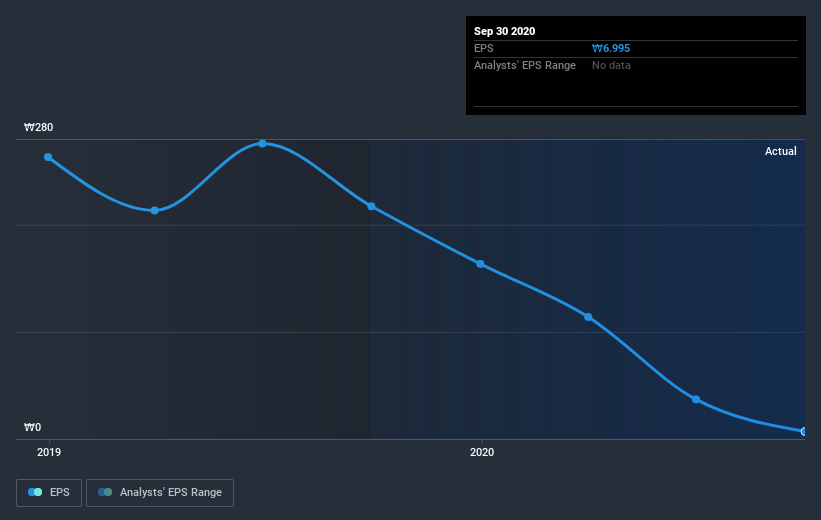- South Korea
- /
- Leisure
- /
- KOSE:A002450
Reflecting on SAMICK MUSICAL INSTRUMENT's (KRX:002450) Share Price Returns Over The Last Five Years
Ideally, your overall portfolio should beat the market average. But the main game is to find enough winners to more than offset the losers So we wouldn't blame long term SAMICK MUSICAL INSTRUMENT Co., Ltd (KRX:002450) shareholders for doubting their decision to hold, with the stock down 52% over a half decade. And we doubt long term believers are the only worried holders, since the stock price has declined 31% over the last twelve months.
See our latest analysis for SAMICK MUSICAL INSTRUMENT
There is no denying that markets are sometimes efficient, but prices do not always reflect underlying business performance. By comparing earnings per share (EPS) and share price changes over time, we can get a feel for how investor attitudes to a company have morphed over time.
During the five years over which the share price declined, SAMICK MUSICAL INSTRUMENT's earnings per share (EPS) dropped by 49% each year. This was, in part, due to extraordinary items impacting earnings. This fall in the EPS is worse than the 14% compound annual share price fall. So the market may previously have expected a drop, or else it expects the situation will improve. The high P/E ratio of 205.15 suggests that shareholders believe earnings will grow in the years ahead.
The graphic below depicts how EPS has changed over time (unveil the exact values by clicking on the image).

It might be well worthwhile taking a look at our free report on SAMICK MUSICAL INSTRUMENT's earnings, revenue and cash flow.
What About Dividends?
When looking at investment returns, it is important to consider the difference between total shareholder return (TSR) and share price return. Whereas the share price return only reflects the change in the share price, the TSR includes the value of dividends (assuming they were reinvested) and the benefit of any discounted capital raising or spin-off. It's fair to say that the TSR gives a more complete picture for stocks that pay a dividend. We note that for SAMICK MUSICAL INSTRUMENT the TSR over the last 5 years was -45%, which is better than the share price return mentioned above. The dividends paid by the company have thusly boosted the total shareholder return.
A Different Perspective
SAMICK MUSICAL INSTRUMENT shareholders are down 29% for the year (even including dividends), but the market itself is up 45%. However, keep in mind that even the best stocks will sometimes underperform the market over a twelve month period. Regrettably, last year's performance caps off a bad run, with the shareholders facing a total loss of 8% per year over five years. We realise that Baron Rothschild has said investors should "buy when there is blood on the streets", but we caution that investors should first be sure they are buying a high quality business. While it is well worth considering the different impacts that market conditions can have on the share price, there are other factors that are even more important. To that end, you should learn about the 4 warning signs we've spotted with SAMICK MUSICAL INSTRUMENT (including 1 which makes us a bit uncomfortable) .
We will like SAMICK MUSICAL INSTRUMENT better if we see some big insider buys. While we wait, check out this free list of growing companies with considerable, recent, insider buying.
Please note, the market returns quoted in this article reflect the market weighted average returns of stocks that currently trade on KR exchanges.
When trading SAMICK MUSICAL INSTRUMENT or any other investment, use the platform considered by many to be the Professional's Gateway to the Worlds Market, Interactive Brokers. You get the lowest-cost* trading on stocks, options, futures, forex, bonds and funds worldwide from a single integrated account. Promoted
New: Manage All Your Stock Portfolios in One Place
We've created the ultimate portfolio companion for stock investors, and it's free.
• Connect an unlimited number of Portfolios and see your total in one currency
• Be alerted to new Warning Signs or Risks via email or mobile
• Track the Fair Value of your stocks
This article by Simply Wall St is general in nature. It does not constitute a recommendation to buy or sell any stock, and does not take account of your objectives, or your financial situation. We aim to bring you long-term focused analysis driven by fundamental data. Note that our analysis may not factor in the latest price-sensitive company announcements or qualitative material. Simply Wall St has no position in any stocks mentioned.
*Interactive Brokers Rated Lowest Cost Broker by StockBrokers.com Annual Online Review 2020
Have feedback on this article? Concerned about the content? Get in touch with us directly. Alternatively, email editorial-team (at) simplywallst.com.
About KOSE:A002450
SAMICK MUSICAL INSTRUMENT
Together with subsidiaries, manufactures, and sells musical instruments in South Korea.
Average dividend payer and fair value.
Market Insights
Community Narratives



